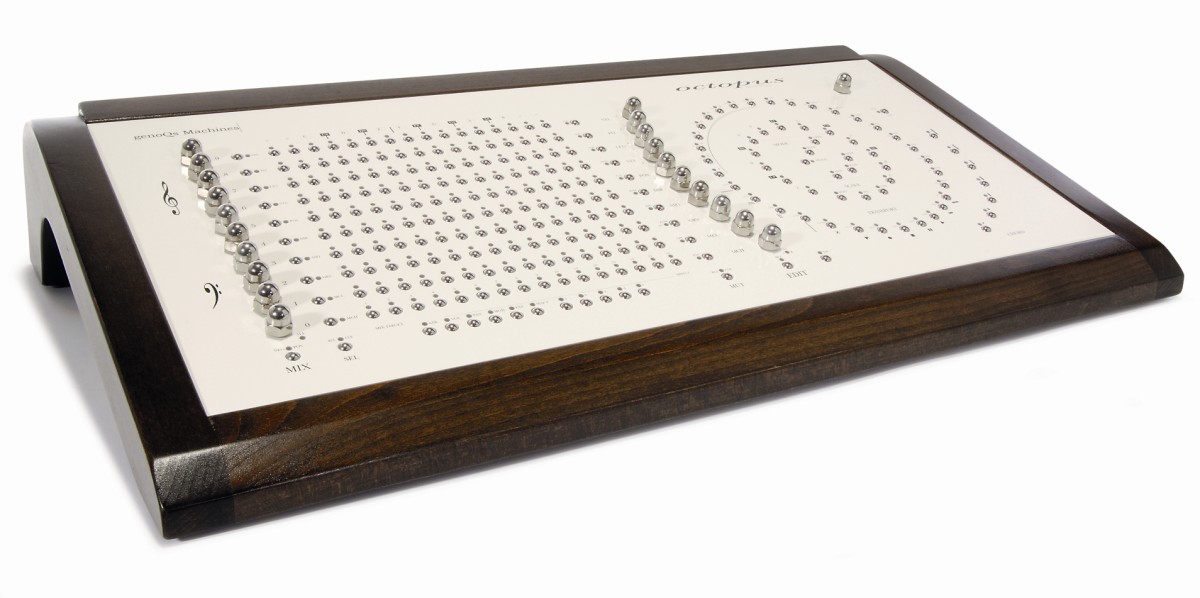MusicRadar Verdict
It´s bonkers, but brilliant. In a predictable world, it´s a marmalade car.
Pros
- +
Beautifully crafted.
Cons
- -
Very expensive.
MusicRadar's got your back


What does the word ‘sequencer´ mean to you? If you´ve come to technology within the last ten years or so, it probably means a combination of hard disk recorder and audio editor plus a suite of soft synths and effects.
If you´re a little older, though, you´ll remember matrix-based step sequencers, either as standalone units, or as functions built into drum machines like Roland´s classic TR-909. German company Genoqs now offers you a chance to sequence in the fashion of yesteryear with their quite extraordinary Octopus.
First of all, let´s deal with the Octopus´ unique appearance. To say it resembles a computer bank from the USS Enterprise probably doesn´t do it justice - but it´s a good place to start. Set into a rich wooden frame, the front fascia houses row after row of silver buttons, each with its own LED. To the right of the instrument there are yet more little buttons, this time arranged in a spiral.
Additionally, two columns of endless rotary dials adorn the panel, with the central curved column flanked by a series of cryptic abbreviations. Making music is, of course, all about sound. And yet how often do you find that gearlust is actually driven by radical design? If you´re drawn to the allure of shiny lights and curious buttons, you need to book into Motel Octopus.
Software
At the moment, the unit rather charmingly ships with operating system V0.9, which suggests that it´s not quite the instrument of our dreams just yet. When the time comes, software updates can be loaded in via MIDI Sysex dumps. And getting started is actually remarkably easy for an instrument that bears little relation to most modern studio gear.
The Octopus´ job is to generate note and MIDI controller information, which in turn can trigger events in any MIDI sound source. On the back panel, you´ll find two sets of MIDI In and Outs, and once you´ve connected the latter of these to the MIDI In on a nearby synth, you´re good to go.
The most basic function of each small silver button in the rows on the left is to generate a note. Each row features 16 buttons, which in turn represent a semiquaver or 16th note. The top row features high notes and the bottom row low ones, so programming a pattern is as simple as activating the relevant button. For each button you press, an LED glows green to show it´s up and running.
Transport functions are featured over to the right, and tempo can be adjusted via a dial at the top. Of course you´re not restricted to just a monophonic pattern; if you highlight more than one button in a vertical column, a chord will play at that location, assuming your playback device works polyphonically.
But this is just the beginning. To the left of each row, there´s an Edit button, each one with its own dedicated function. The controllable parameters are: Velocity, Pitch, Length, Start, Position, Direction, Amount, Groove, MIDI Continuous Controller and MIDI Channel. All of these work in tandem with the rotary dials that lie at the other end of the sequence rows.
LED
It´s when you begin delving into the edit functions like these that the bright LED display really excels. As the sequence plays and you make your chosen edit, the LEDs temporarily turn red and the whole row becomes a status display for note length, for example. If you´re making your notes shorter, only the left-hand LEDs are red, but as soon as you begin to lengthen the note, the row of LEDs lengthens accordingly, from left to right. Do this with pitch, and it´s vertical movement that you´ll see, indicating the 'height' of the pitch.
If you´re scratching your head, fear not; it´s easier to do than describe! Choosing whether editing will affect just one note or an entire row means that your carefully constructed pattern can quickly become a very different animal. Rows can be chained together too, so you´re not restricted to 16 steps.
The Octopus is a designer´s dream and this extends beyond the wow-factor of its lights. It´s more straightforward to use than you´d think, although anything beyond basic functionality can become complex quite quickly.
So who´s going to buy one? Well, that´s not an easy question to answer. Without a doubt though, it´s the Aston Martin of hardware sequencers, so if you´ve got the necessaries burning a hole in your pocket, and your studio is crying out for something creative, fun and unique then call off the dogs - the search is over.
MusicRadar is the number 1 website for music makers of all kinds, be they guitarists, drummers, keyboard players, djs or producers...
GEAR: We help musicians find the best gear with top-ranking gear round-ups and high- quality, authoritative reviews by a wide team of highly experienced experts.
TIPS: We also provide tuition, from bite-sized tips to advanced work-outs and guidance from recognised musicians and stars.
STARS: We talk to musicians and stars about their creative processes, and the nuts and bolts of their gear and technique. We give fans an insight into the actual craft of music making that no other music website can.
“This update reflects everything we believe modern gear should be”: Neural DSP gives the Nano Cortex an almighty power-up with free NanOS 2.0.0 system update
“It’s honestly got me thinking hard about adding one to my own studio set up”: Two Notes Reload II review
“Gloriously adorned with a gold edge burst finish over a gold paisley and sparkle top”: Gretsch unveils the Paisley Penguin – a rare bird that growls – and the Honey Dipper Special, a resonator for all your roots rock manoeuvres










